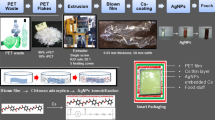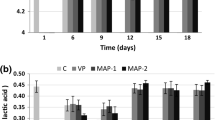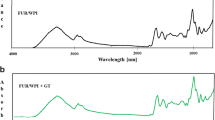Abstract
In this study, we compared the effect of basil essential oil (EO) and various packaging conditions on “Anthotyros,” a Greek whey cheese. This cheese was stored at 4 °C under aerobic (A), vacuum (V), and modified atmosphere (M, 40%/60%; CO2/N2,) conditions, without or with (AB, VB, and VM) basil EO added to the cheese samples to a final concentration of 0.4% (v/w). The quality characteristics and the shelf life of both untreated and basil EO-treated cheese were assessed using microbiological, physicochemical, and sensory parameters. Microbiological results revealed that either modified atmosphere/vacuum packaging (MAP/VP) singly or in combination with basil EO delayed microbial growth as compared to the control (A) samples. The sensory and microbiological data showed that the combined use of MAP and VP with added basil EO extended the shelf life of fresh Anthotyros (4 °C) by approximately 10–12 days (treatment MB) and 6 days (treatment VB) as compared to aerobic packaging (A). Under these treatments, whey cheese samples maintained good sensory characteristics. This study has shown that the combined use of either VP or MAP, and basil EO, can extend the shelf life of whey cheese and maintain the freshness and the sensorial characteristics of the product.





Similar content being viewed by others
References
Anifantakis, E. (1991). Greek cheeses. Athens: National Dairy Committee of Greece.
Association of Official Analytical Chemists (AOAC). (1990). Official methods of analysis (14th ed.). Washington, DC: Association of Official Analytical Chemists.
Atrea, I., Papavergou, A., Amvrosiadis, I., & Savvaidis, I. N. (2009). Combined effect of vacuum-packaging and oregano essential oil on the shelf-life of Mediterranean octopus (Octopus vulgaris) from the Aegean sea stored at 4 °C. Food Microbiology, 26, 166–172.
Bagamboula, C. F., Uyttendaele, M., & Debevere, J. (2004). Inhibitory effect of thyme and basil essential oils, carvacrol, thymol, estragol, linalool and p-cymene towards Shigella sonnei and S. flexneri. Food Microbiology, 21, 33–42.
Beresford, T. O., Fitzsimmons, N. A., Brennan, N. L., & Cogan, T. M. (2001). Recent advances in cheese microbiology. International Dairy Journal, 11, 259–274.
Brody, A. L. (1989). Controlled modified atmosphere/vacuum packaging of foods (1st ed.). Trumbull: Food and Nutrition Press, Inc.
Burt, S. (2004). Essential oils: their antibacterial properties and potential applications in foods—a review. International Journal of Food Microbiology, 94, 223–253.
Deans, S. G., & Ritchie, G. (1987). Antibacterial properties of plant essential oils. International Journal of Food Microbiology, 5, 165–180.
Deeth, H. C., & Fitz-Gerald, C. H. (1976). Lipolysis in dairy products: a review. The Australian Journal of Dairy Technology, 31, 53–64.
Del Nobile, Μ. Α., Conte, A., Incoronato, A. L., & Panza, O. (2009). Modified atmosphere packaging to improve the microbial stability of Ricotta. African Journal of Microbiology Research, 3, 137–142.
Dermiki, M., Ntzimani, A., Badeka, A., Savvaidis, I. N., & Kontominas, M. G. (2008). Shelf-life extension and quality attributes of the whey cheese ‘Myzithra Kalathaki’ using modified atmosphere packaging. Lebensmittel Wissenschaft-und–Technologie, 41, 284–294.
Eliot, S. C., Vuillemard, J. C., & Emond, J. P. (1998). Stability of shredded Mozzarella cheese under modified atmospheres. Journal of Food Science, 63, 1075–1080.
Farber, J. M. (1991). Microbiological aspects of modified atmosphere packaging technology—a review. Journal of Food Protection, 54, 58–70.
Freedman, D. J., Kondo, K., & Willrett, D. L. (1989). Antagonism of foodborne bacteria by Pseudomonas spp.: a possible role for iron. Journal of Food Protection, 52, 484–489.
Fyfe, L., Armstrong, F., & Stewart, J. (1998). Inhibition of Listeria monocytogenes and Salmonella enteritidis by combinations of plant oils and derivatives of benzoic acid: the development of synergistic antimicrobial combinations. International Journal of Antimicrobial Agents, 9, 195–199.
Giatrakou, V., Ntzimani, A., Zwietering, M., & Savvaidis, I. N. (2010). Combined chitosan–thyme treatments with modified atmosphere packaging on a Greek ready-to-cook (RTC) poultry product. Journal of Food Protection, 73, 663–669.
Giovana Tommaso, T., Souza de Moraes, B., Cruz Macedo, G., Sousa Silva, G., & Setsuko Kamimura, E. (2011). Production of lipase from Candida rugosa using cheese whey through experimental design and surface response methodology. Food and Bioprocess Technology. doi:10.1007/s11947-010-0432-3.
Gonzalez-Fandos, E., Sanz, S., & Olarte, C. (2000). Microbiological, physicochemical and sensory characteristics of Cameros cheese packaged under modified atmospheres. Food Microbiology, 17, 407–414.
Govaris, A., Koidis, P., & Papatheodorou, K. (2001). The fate of Escherichia coli O157: H7 in Myzithra, Anthotyros and Manouri whey cheeses during storage at 2 and 12°C. Food Microbiology, 18, 565–570.
Gutierrez, J., Barry-Ryan, C., & Bourke, P. (2008). The antimicrobial efficacy of plant essential oil combinations and interactions with food ingredients. International Journal of Food Microbiology, 124, 91–97.
Hocking, A. D., & Faedo, M. (1992). Fungi causing thread mold spoilage of vacuum packaged cheddar during maturation. International Journal of Food Microbiology, 16, 123–130.
IDF. (1995). Guide for the sensory evaluation of cheese. Standard 99A, part IV. Brussels: International Dairy Federation.
Kalogridou-Vassiliadou, D., Tzanetakis, N., & Litopoulou-Tzanetaki, E. (1994). Microbiological and physicochemical characteristics of Anthotyros, a Greek traditional whey cheese. Food Microbiology, 11, 15–19.
Kneifel, W., Ulberth, F., & Schaffer, E. (1992). Tristimulus colour reflectance measurement of milk and dairy products. Le Lait, 72, 383–391.
Kristensen, D., Orlien, V., Mortensen, G., Brockhoff, P., & Skibsted, L. H. (2000). Light-induced oxidation in sliced Havarti cheese packaged in modified atmospheres. International Dairy Journal, 10, 95–103.
Lachowicz, K. J., Jones, G. P., Briggs, D. R., Bienvenu, F. E., Wan, J., Wilcock, A., et al. (1998). The synergistic preservative effects of the essential oils of sweet basil (Ocimum basilicum L.) against acid- tolerant food microflora. Letters in Applied Microbiology, 26, 209–214.
Lioliou, K., Litopoulou-Tzanetaki, E., Tzanetakis, N., & Robinson, R. K. (2001). Changes in the microflora of Manouri, a traditional Greek whey cheese, during storage. International Journal of Dairy Technology, 54, 100–106.
Maniar, A. B., Marcy, J. E., Russell-Bishop, J., & Duncan, S. E. (1994). Modified atmosphere packaging to maintain direct-set Cottage cheese quality. Journal of Food Science, 59, 1305–1308.
Moreira, M. R., Ponce, A. G., Valle, C. E., & Roura, S. I. (2005). Inhibitory parameters of essential oils to reduce a foodborne pathogen. Lebensmittel Wissenschaft und –Technologie, 38, 565–570.
Nedorostova, L., Kloucek, P., Kokoska, L., Stolcova, M., & Pulkrabek, J. (2009). Antimicrobial properties of selected essential oils in vapor phase against foodborne bacteria. Food Control, 20, 157–160.
Ntzimani, A., Giatrakou, V., & Savvaidis, I. N. (2010). Combined natural antimicrobial treatments (EDTA, lysozyme, rosemary and oregano oil) on semi cooked coated chicken meat stored in vacuum packages at 4 °C: microbiological and sensory evaluation. Innovative Food Sciemce and Emerging Technologies, 11, 187–196.
Opalchenova, G., & Obreshkova, D. (2003). Comparative studies on the activity of basil—an essential oil from Ocimum basilicum L.—against multidrug resistant clinical isolates of the genera Staphylococcus, Enterococcus and Pseudomonas by using different test methods. Journal of Microbiology Methods, 54, 105–110.
Papaioannou, G., Chouliara, I., Karatapanis, A., Kontominas, M. G., & Savvaidis, I. N. (2007). Shelf-life of a Greek whey cheese under modified atmosphere packaging. International Dairy Journal, 17, 358–364.
Pintado, M. E., Macedo, A. C., & Malcata, F. X. (2001). Review: technology, chemistry and microbiology of whey cheeses. Food Science and Technology International, 7, 105–116.
Pintado, M. E., & Malcata, F. X. (2000). Characterization of whey cheese packaged under vacuum. Journal of Food Protection, 63, 216–221.
Politeo, O., Jukic, M., & Milos, M. (2007). Chemical composition and antioxidant capacity of free volatile aglycones from basil (Ocimum basilicacum L.) compared with its essential oil. Food Chemistry, 101, 379–385.
Runyoro, D., Ngassapa, O., Vagionas, K., Aligiannis, N., Graikou, K., & Chinou, J. (2009). Chemical composition and antimicrobial activity of the essential oils of four Ocimum species growing in Tanzania. Food Chemistry, 119, 311–316.
Smith-Palmer, A., Stewart, J., & Fyfe, L. (2001). The potential application of plant essential oils as natural food preservatives in soft cheese. Food Microbiology, 18, 463–470.
Tsiotsias, A., Savvaidis, I. N., Vassila, A., Kontominas, M. G., & Kotzekidou, P. (2002). Control of Listeria monocytogenes by low-dose irradiation in combination with refrigeration in the soft whey cheese Anthotyros. Food Microbiology, 19, 117–126.
Valderrama Solano, A. C., & de Rojas Gante, C. (2011). Two different processes to obtain antimicrobial packaging containing natural oils. Food and Bioprocess Technology. doi:10.1007/s11947-011-0626-3.
Wei, H., Wolf, G., & Hammes, W. P. (2006). Indigenous microorganisms from iceberg lettuce with adherence and antagonistic potential to use as protective culture. Innovative Food Science and Emerging Technologies, 7, 294–301.
Author information
Authors and Affiliations
Corresponding author
Rights and permissions
About this article
Cite this article
Tsiraki, M.I., Savvaidis, I.N. Effect of Packaging and Basil Essential Oil on the Quality Characteristics of Whey Cheese “Anthotyros”. Food Bioprocess Technol 6, 124–132 (2013). https://doi.org/10.1007/s11947-011-0676-6
Received:
Accepted:
Published:
Issue Date:
DOI: https://doi.org/10.1007/s11947-011-0676-6




